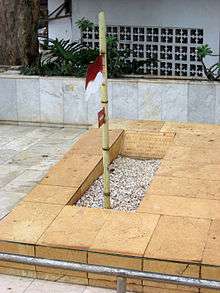Fatmawati
| Fatmawati | |
|---|---|
.jpg) Fatmawati Soekarno (1966) | |
| 1st First Lady of Indonesia | |
|
In office 17 August 1945 – 12 March 1967 | |
| President | Soekarno |
| Succeeded by | Tien Soeharto |
| Personal details | |
| Born |
5 February 1923 Bengkulu, Dutch East Indies |
| Died |
14 May 1980 (aged 57) Kuala Lumpur, Malaysia |
| Resting place |
Karet Cemetery Jakarta, Indonesia |
| Nationality | Indonesian |
| Spouse(s) | Sukarno |
| Children |
Sukmawati Soekarnoputri |
| Religion | Islam |
Fatmawati (5 February 1923 – 14 May 1980)[1] is a National Hero of Indonesia (Indonesian: Pahlawan Nasional Indonesia). As the first Indonesian First Lady, She was the third wife of Sukarno, the first president of Indonesia, and the mother of Indonesia's first female president, Megawati Sukarnoputri. She constructed the first flag flown by Indonesia.[2]
Life

Fatmawati was born on 5 February 1923 in Bengkulu to Hasan Din and Chadijah.[3] One of her ancestors was a princess of a Minangkabau kingdom, Sultanate of Inderapura.[4] When she met Sukarno she was a teenager and he was married to a 53-year-old woman named Inggit. Unsurprisingly, Sukarno's wife was unwilling to release her husband but, after two years, Inggit agreed to a divorce. Sukarno rationalised the need for his new wife by stating his desire to have a child to carry on his name.[5]

In 1943 Fatmawati became the third wife of Sukarno and the following year gave birth to his first child, a son. Sukarno named his child Guntur meaning thunder. In 1945 she was his wife when Indonesia declared independence. The flag of the new country was sewn by Fatmawati,[2] and the same flag was flown again every year until 1967. She was not his first wife, as he had married several times before. However, all his previous wives had been divorced in accordance with state law. Fatmawati was therefore his only wife at that time.
Polygamy

There was a growing movement to reform women's rights in Indonesia and part of this was to reform the marriage laws. Fatmawati was not initially in favour of reforming these laws until she found out about her husband's intentions to marry again. Moreover, this time Sukarno had decided that he did not want to divorce Fatmawati but intended to have two wives.[6]
Fatmawati objected when her husband took Hartini, his new wife, according to Muslim law. Sukarno married another woman from Java in 1953 and Fatmawati moved out of the presidential palace and lived separately in Jakarta.[7] As part of the settlement Fatmawati was allowed to keep the title of First Lady.[5] This development was a major blow to the growing women's movement. Fatmawati decided that she was going to divorce the President, but she could not find a religious leader who was willing to oppose the will of Sukarno.[6] The women's organisation consoled and advised Fatmawati and they tried to encourage her to return to the palace and reestablish her rights. Sukarno himself was annoyed by this development although his new wife understood Fatmawati's anger.[8]
Sukarno's new wife bore him two additional children; however, Sukarno reacted badly when he heard that his latest wife had allowed a women's group to consider transferring the title of First Lady to her. Sukarno returned and had her thrown out of the meeting and exiled to Bogor.[5]
In 1953 Fatmawati became concerned about the plight of children with tubercolosis. She founded the Ibu Soekarno Foundation to fund a hospital. The following year a hospital was opened with the assistance of government funding. This was called the Madam Soekarno Hospital and Fatmawati laid the foundation stone in 1954. The birth of the hospital was a long one. The construction of the new building was halted by financial problems and it was not until 1961 that the hospital opened. By that time the hospital was run by the Ministry of Health and it did not specialise in tuberculosis or children but was a general hospital. In 1967 the name was changed to the Fatmawati Central General Hospital.[9]
Fatmawati's second child, Megawati Soekarnoputri, was a daughter who became president herself in 2001.
Death

Fatmawati died of a heart attack on 14 May 1980 in Kuala Lumpur, Malaysia, on her way back to Jakarta from an umra in Mecca.[3] She is buried in Karet Bivak Cemetery, Central Jakarta.
Legacy
Fatmawati Soekarno Airport in Bengkulu and a hospital in South Jakarta are named after her.
References
- ↑ Tiga Putri Bung Karno Raih Penghargaan MURI (Indonesian)
- 1 2 3 MacDonald, Ian (2006). "Indonesia". Flags of the World. Retrieved 13 March 2010.
- 1 2 Biography of Fatmawati (Indonesian)
- ↑ Agus, Yusuf, Sejarah Pesisir Selatan, Jakarta : PT. Arina Yudi, 2001
- 1 2 3 Friend, Theodore (2003). Indonesian Destinies p.74 et al. Harvard University Press. p. 628. ISBN 978-0-674-01137-3. Retrieved March 2010. Check date values in:
|access-date=(help) - 1 2 Wieringa, Saskia (2002). Sexual politics in Indonesia p115 et al. Palgrave Macmillan. p. 390. ISBN 978-0-333-98718-6. Retrieved March 2010. Check date values in:
|access-date=(help) - ↑ Geerken, Horst H (2010). A Gecko for Luck p180. BoD – Books on Demand. p. 394. ISBN 978-3-8391-5248-5. Retrieved 28 November 2013.
- ↑ The women's movement in post-colonial Indonesia, Elizabeth Martyn, p137, 2005. Retrieved March 2010
- ↑ History of Hospital. Retrieved March 2010
| Preceded by New title |
First Lady of Indonesia 1945–1967 |
Succeeded by Tien Soeharto |